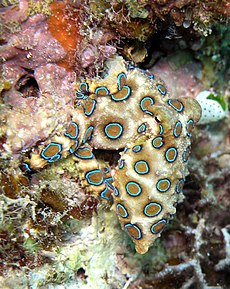Hapalochlaena
| Blue-ringed octopus | |
|---|---|
 |
|
|
Greater blue-ringed octopus (Hapalochlaena lunulata) |
|
| Scientific classification | |
| Kingdom: | Animalia |
| Phylum: | Mollusca |
| Class: | Cephalopoda |
| Order: | Octopoda |
| Family: | Octopodidae |
| Subfamily: | Octopodinae |
| Genus: |
Hapalochlaena Robson, 1929 |
| Species | |
H. fasciata
H. lunulata
H. maculosa
H. nierstraszi (?)
The blue-ringed octopodes (genus Hapalochlaena) are three octopus species that live in tide pools and coral reefs in the Pacific and Indian Oceans, from Japan to Australia. Their primary habitat is around southern New South Wales, South Australia, and northern Western Australia. They are recognized as one of the world's most venomous marine animals. Despite their small size, 12 to 20 cm (5 to 8 in), and relatively docile nature, they are dangerous to humans if provoked and handled, because their venom contains tetrodotoxin, a neurotoxin powerful enough to kill humans.
They can be identified by their characteristic blue and black rings, and yellowish skin. When the octopus is agitated, the brown patches darken dramatically, iridescent blue rings, or clumps of rings, appear and pulsate within the maculae. Typically, 50–60 blue rings cover the dorsal and lateral surfaces of the mantle.
They hunt small crabs, hermit crabs, shrimp, and other small crustaceans.
The genus was described by British zoologist Guy Coburn Robson in 1929. There are four confirmed species of Hapalochlaena, and six possible species still being researched:
...
Wikipedia
